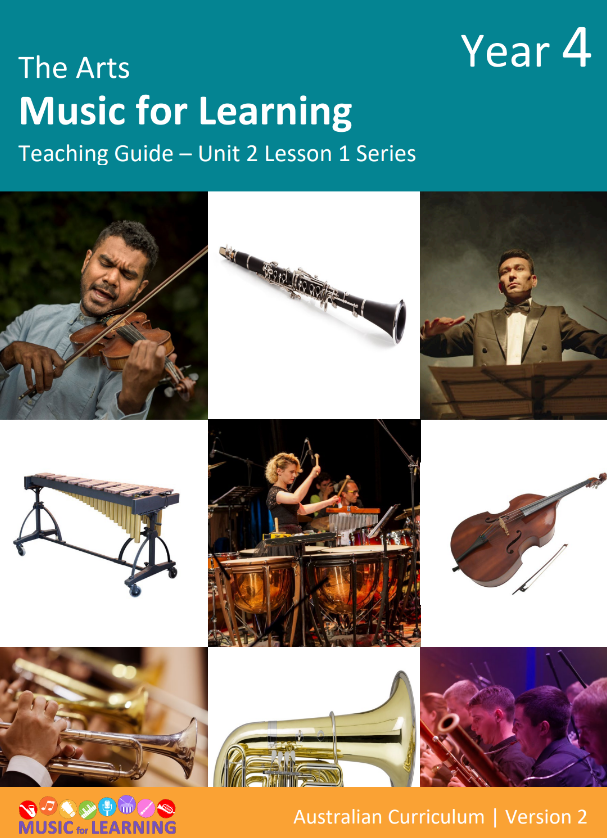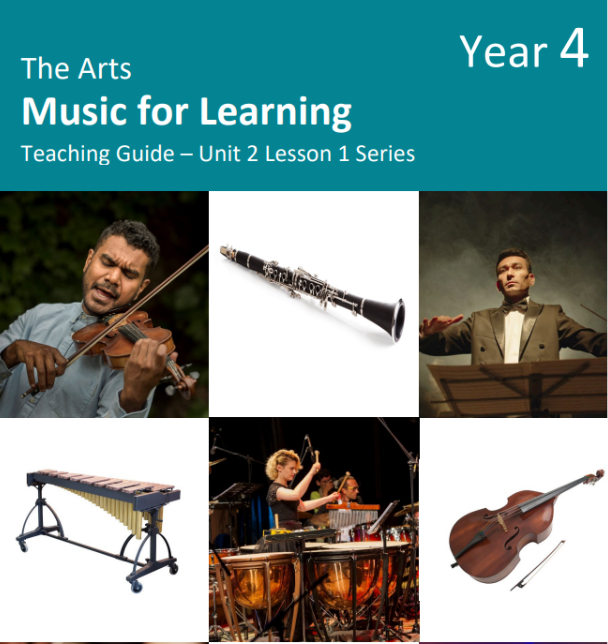Unit 2 Year 4
Music For Learning

Overview
In Year 4 Unit 2, Instruments of the Orchestra, students develop an understanding of the elements of music through listening, exploring, responding, composing and performing activities.
They have a particular focus on timbre in recognising and categorising orchestral instruments.
Students focus on a variety of repertoire to build on their skills in aurally and visually recognising ta, titi, za and ta-a, as well as the pitch sets d-r-m-s-l, m-r-d-s, and l,-d-r-m-s.
It aligns to the Australian Curriculum, Version 9:
- AC9AMU4E01 – Explore where, why and how music is composed and/or performed across cultures, times, places and/or other contexts.
- AC9AMU4E02 – Explore how First Nations Australians use music to communicate their connection to and responsibility for Country/Place.
- AC9AMU4D01 – Develop listening skills and skills manipulating elements of music when singing and playing instruments.
- AC9AMU4C01 – Manipulate elements of music to communicate ideas, perspectives and/or meaning when composing and practising for performance.
- AC9AMU4P01 – Sing and play music they have learnt and/or composed in informal settings.
Learning objectives
Lesson 1 Series:
- Identify and sing the minor pentatonic scale.
- Learn to identify and sing s,.
- Sing in unison and in up to 3 parts.
- Sing folksongs in words, time names and sol-fa.
- Distinguish between major and minor tonalities.
- Notate rhythms in simple triple and simple quadruple time.
- Visually and aurally identify orchestral instruments, their family, mode of sound production and their timbre.
- Create a musical structure using a known song.
- Complete an aural and written assessment task.
Lesson 2 Series:
- Sing in unison and in a round.
- Learn to recognise s, and l, when they see it and hear it.
- Read and perform rhythms in simple time signatures.
- Memorise, rehearse and perform ‘The Instrument Song,’ ‘The Riddle Song,’ ‘The Birch Tree’ and ‘Yonder Mountain’.
- Be introduced to the concept of a leitmotif and how a character can be represented in music.
- Practice good performing behaviours.
Teaching resources
- 18 PowerPoint lessons with all videos embedded
- Teaching Guide
- Teaching Resources
- Teaching Assessment Book
- Student Workbook
- Student Assessment Book
Assessment
End-of-Unit Assessment
The End-of-Unit Assessment occurs in Week 8 of the Lesson 1 Series. It consists of a written test based on:
- s, l, drm sl
- titi, ta-a, za, ta
- 3/4 & 4/4 metres
- major & minor tonalities
- defining ballad, round, form, timbre
- matching instruments of the orchestra to their families
- identifying instruments of the orchestra visually and aurally.



Responses